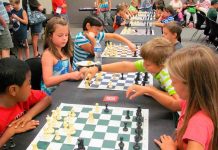Токарева Гузель Фаридовна
учитель английского языка
МАОУ «Гимназия №77» г.Набережные Челны
Развитие критического мышления по тексту “Virtual Reality: Danger Ahead?”
8 класс
Учебник: Афанасьева О.В. Английский язык
Аннотация: Урок полностью построен на структурах сингапурской методики обучения. Материал будет полезен в первую очередь учителям, знакомых с данной методикой, и работающих по учебнику Афанасьевой О.В. для школ с углубленным изучением английского языка.
Учителя, находящиеся в творческом поиске, благодаря данному конспекту смогут открыть для себя новые приемы работы с учебным материалом.
Использование технологии развития критического мышления на данном уроке направлено на формирование коммуникативной компетенции (устной и письменной). Обсуждаемая тема («Виртуальная реальность») рассматривается с положительной и отрицательной сторон.
Цели:
-
Образовательные:
— активизировать ЛЕ по теме «Наука и технологии»,
— формировать навыки говорения по теме,
— развивать навыки аудирования,
-
Развивающие:
— развивать критическое мышление,
— способствовать развитию памяти, внимания, логики, мышления,
-
Воспитательные:
— воспитывать терпимое отношение к мнению других людей, умение работать в группах, в парах,
— способствовать повышению интереса к изучению английского языка.
Форма проведения: 3-4 команды по 4 человека
Оборудование: Мэнэдж Мэт, листы А4, учебник
Ход урока
I Начальный этап
-
Приветствие
-
Знакомство с целями урока/Мотивация
Teacher: We continue to speak about science and technology. Technology is an important part of our life. A lot of people can’t imagine their life without a notebook or Internet. What about you? What is your attitude to technology? Let’s have a short survey. (анкетирование учащихся, аудирование)
-
-
You use the internet very first thing in the morning.
-
Yes
-
No
-
A day without viewing your myspace (Facebook…) account will be…
-
Dreadful
-
Normal
-
You have more virtual friends than real.
-
Yes
-
No
-
On your birthday, you receive more greetings on myspace (Facebook…) than in real life.
-
Yes
-
No
-
When your internet is down or your computer is broken, it literally throws you into a panic.
a) Yes
b) No
6. Do you spend more than three hours a day surfing the Web?
a) Yes
b) No
7. Do you lie about the amount of time you spend on computer activities?
-
Yes
-
No
8. Do you skip meals or eat at your computer so that you can stay online?
-
Yes
-
No
9. Do you experience a sense of euphoria, excitement or relief when you’re at the computer?
-
Yes
-
No
Results:
If you gave 0-3 “A” Answers
Congratulations! You probably have very little tendency to waste time surfing the net. You probably do exotic things like reading books and going outside and speaking to people face-to-face.
If you gave 4-6 “A”Answers
You like the internet..a lot…But you’re not addicted to it. You have a balanced relationship with your online use, and that’s a good thing.
If you gave 7-9 “A” Answers
The Internet has become a part of your daily life. You know your way around a computer, so if anyone needed tech-help, you would be the one to choose! But please, GET OFF THE COMPUTER AND DO ANYTHING ELSE!!!
-
Teacher: According to the results most of you are active users of computers and the Internet. But I am sure you know that there are a lot of disadvantages of virtual reality as well as advantages. Let’s discuss this topic.
II Основной этап
-
Работа с лексикой по тексту “Virtual Reality: Danger Ahead?”
-
Teacher: Let’s revise our active vocabulary. Match the English words and their Russian equivalents. (Ex.18 p.148)
-
Let’s do “Tic-tac-toe” structure (think of 3 sentences) + Continuous Round Robin (choose the best sentence)
Пояснение: Учитель раздает каждой команде карточки с активной лексикой. Ученик №1 смешивает карты, и раскладывает их на столе по схеме 3х3. Ученики пронумеровывают карточки от 1 до 9. Ученики самостоятельно записывают предложения, используя 3 слова по вертикали, горизонтали или диагонали по принципу «крестики-нолики» (“Tic—tac—toe”). Когда время заканчивается, ученики обмениваются предложениями с членами своей команды, используя структуру Continuous Round Robin, т.е. в команде по очереди зачитываются предложения. Затем в команде выбирают лучшее предложение. Его зачитывают всему классу.
Лексические единицы для “Tic-tac-toe”: to interact, make-believe worlds, both real and potential, side effects, to effect our minds, without careful regulation, high-tech, to spread violence, to damage
-
Говорение по тексту “Virtual Reality: Danger Ahead?”
Teacher: Did you read the article “Virtual Reality: Danger Ahead?” at home? So let’s answer some questions.
Let’s do “Timed-Pair-Share” structure with your shoulder partner. (учитель задает вопрос, дает 15 сек на размышление, 30 сек – на ответ каждому ученику)
Questions:
-
What kind of war is described at the beginning of the text?
-
What are the advantages of the new virtual technology?
-
What in virtual technologies may turn out to be dangerous in training?
-
What may happen to human ethics and morality as a result of using virtual technologies?
-
Обсуждение темы “ Advantages and disadvantages of Virtual Reality”
-
Let’s do “Stir the class” structure
Teacher: Take a piece of paper. Draw two columns: advantages and disadvantages of Virtual Reality.Write your ideas. Draw a line. Move around the class to find out more ideas. Discuss your results in the group (Continuous Round Robin). Count advantages and disadvantages in your list. Whose list is the longest? Read and the rest add the information into your list.
Пояснение: Учащиеся передвигаются по классу для того, чтобы добавить как можно больше идей участников к своему списку.
Пример:
-
Virtual Reality
Advantages
Disadvantages
You can learn the latest news
Access useful information
Communicate with friends
Watch films
Doctors can practise operations on different parts of human bodies
…
Can spread violence, pornography and advertising
Exercises in killing rather than in thinking
People can mix the real world with the virtual one
Do much harm to our health
…
-
Teacher: Let’s do “Claim-Support-Question” structure
On the pieces of paper you can see a statement: “Virtual Reality serves for educational purposes”. You are to fill in the chart.
Пояснение: Ученики определяют факты или доказательства в поддержку данного утверждения, во втором столбике задают вопросы для дальнейшего изучения этой темы или ставят под сомнение предоставленные доказательства.
Пример:
-
Virtual Reality serves for educational purposes
Arguments
Questions
We can learn geography and history by “walking” into the places we are interested in.
We can’t feel the real atmosphere of the place, can we?
We can access useful information
We can’t be sure that this information is true, can we?
…
…
Rally Robin: share your ideas with your shoulder partner.
Пояснение: два участника (партнеры по плечу) поочередно зачитывают свои утверждения и вопросы.
III Заключительный этап
-
Выставление оценок
-
Объяснение д/з
Prepare a short report “Advantages and disadvantages of Virtual Reality”
-
«Билетик на выход» (генеративный вопрос)
How would people change if there were no virtual reality?
Пояснение: прежде чем покинуть кабинет, учащиеся на листочках пишут свой ответ на вопрос.
Список литературы и интернет-ресурсов:
-
Преобразование обучения в XXI веке: развитие культуры мышления /сост.Майк Тируман. – Казань: ИРО РТ, 2014
-
Афанасьева О.В. Английский язык: Учеб. для 8 кл. с углубл. изучением англ.яз., лицеев и гимназий.- М.: Просвещение, 2008
-
Материал для анкеты:
http://www.blogthings.com/areyouaddictedtotheinternetquiz/
http://www.funquizcards.com/quiz/computers-internet/are-you-addicted-to-myspace.php
http://ucsccares.ucsc.edu/self-help/computer-or-internet-addiction.html





